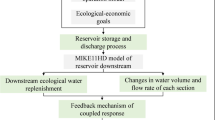Abstract
Dam construction in arid and semiarid regions is generally related to the risk of increased salinity, due to water passage in contact with salty formations. Hence, it is important to take reservoir thermal and salinity stratification into account in operational rules. In the present study, a simulation–optimization model was developed to determine the amount of water release from various outlets to discharge the brine from hypolimnion layer considering the downstream water quality limitations. The most appropriate time, rate, and concentration to release brine were determined based on water consumption conditions and downstream water demand and river ecology characteristics. The proposed methodology was used to improve the water quality condition of Gotvand Dam constructed over Karun River in southwest Iran. The dissolution of the Gachsaran formation located in Gotvand Dam reservoir has gradually increased the salinity of hypolimnion layer water three times more than that of the seawater salinity. The results indicated that late winter is the most appropriate time to release brine water. If the brine water is not released, the very salty water gradually encompasses the epilimnion layer when the reservoir dead storage is filled with sediment. Results show that the TDS concentration of epilimnion layer gradually increases until 8000 mg/l by increasing the volume of reservoir sediments, which may be regarded as the source of economic, social, and environmental crisis.




Similar content being viewed by others
Notes
Computational Aquatic Ecosystem Dynamics Model.
References
Annear R, Wells S (2002) The Bull Run River—reservoir system model. In: Proceedings, 2nd federal inter agency hydrologic modeling conference, Las Vegas, July 28–Aug 1
Asaeda T, Pham HS, Nimal Priyantha DG, Manatunge J, Hocking GC (2001) Control of algal blooms in reservoirs with a curtain: a numerical analysis. Ecol Eng 16(3):395–404
Balistrieri L, Tempel RN, Stillings L, Shevenell L (2006) Modeling spatial and temporal variations in temperature and salinity during stratification and overturn in Dexter Pit Lake, Tuscarora, Nevada, USA. Appl Geochem 21(7):1184–1203
Chung SW, Oh JK (2006) Calibration of CE-QUAL-W2 for a monomictic reservoir in a monsoon climate area. Water Sci Technol 54(11–12):29–37
Coelho L (2009) Multi-objective swarm intelligent systems: theory & experiences, vol 261. Springer, Berlin
Cole TM, Wells SA (2008) CE-QUAL-W2: a two-dimensional, laterally averaged, hydrodynamic and water quality model, Version 3.6. User Manual. U.S. Army Corps of Engineers. Hydrology Section Water Control and Water Quality section
Gal G, Imberger J, Zohary T, Antenucci J, Anis A, Rosenberg T (2003) Simulating the thermal dynamics of Lake Kinneret. Ecol Model 162(1–2):69–86
Han P, Armengol J, Garcia CJ, Comerma M, Roura M, Dolz J, Straskraba M (2000) The thermal structure of Sau Reservoir (NE: Spain): a simulation approach. Ecol Model 125(2–3):109–122
Hobson P, Fabris R, Develter E, Linden LG, Burch MD, Brookes JD (2010) Reservoir inflow monitoring for improved management of treated water quality—a South Australian experience. Water Resour Manag 24:4161–4174
Hudak JP (2011) Stream diversion management to improve water quality in a Connecticut water supply reservoir. Lake Reserv Manag 27(1):41–47
Jan-Tai L, Wen-Cheng K, Ruey-Tyng L, Wu-Seng L, Chou-Ping Y, Show-Chyuan C (2002) Water quality modeling the Feitsui Reservoir in northern Taiwan. J AWRA 39(3):671–687
Moridi A (2018) Dealing with reservoir eutrophication in a trans-boundary river. Int J Environ Sci Technol. https://doi.org/10.1007/s13762-018-1775-y
Moridi A, Yazdi J (2017) Sediment flushing of reservoirs under environmental considerations. Water Resour Manag 31(6):1899–1914
Nicholson GS, Pyatt EE, Moreau DH (1970) A methodology for selecting among water quality alternatives. Water Resour Bull 6:23–33
Scharf W (2008) The use of nutrient reduction and food-web management to improve water quality in the deep stratifying Wupper Reservoir, Germany. Hydrobiologia 603:105–115. https://doi.org/10.1007/s10750-007-9250-7
Shourian M, Moridi A, Kaveh M (2016) Modeling of eutrophication and strategies for improvement of water quality in reservoirs. Water Sci Technol 74(6):1376–1385
Yazdi J, Moridi A (2017) Interactive reservoir-watershed modeling framework for integrated water quality management. Water Resour Manage 31(7):2105–2125
Acknowledgements
This paper is based on PhD dissertation results done in Department of Environmental Engineering, Faculty of Environment and Energy, Science and Research Branch, Islamic Azad University, Tehran, Iran.
Author information
Authors and Affiliations
Corresponding author
Ethics declarations
Conflict of interest
None.
Additional information
Editorial responsibility: M. Abbaspour.
Rights and permissions
About this article
Cite this article
Aghasian, K., Moridi, A., Mirbagheri, A. et al. Selective withdrawal optimization in a multipurpose water use reservoir. Int. J. Environ. Sci. Technol. 16, 5559–5568 (2019). https://doi.org/10.1007/s13762-019-02363-x
Received:
Revised:
Accepted:
Published:
Issue Date:
DOI: https://doi.org/10.1007/s13762-019-02363-x




